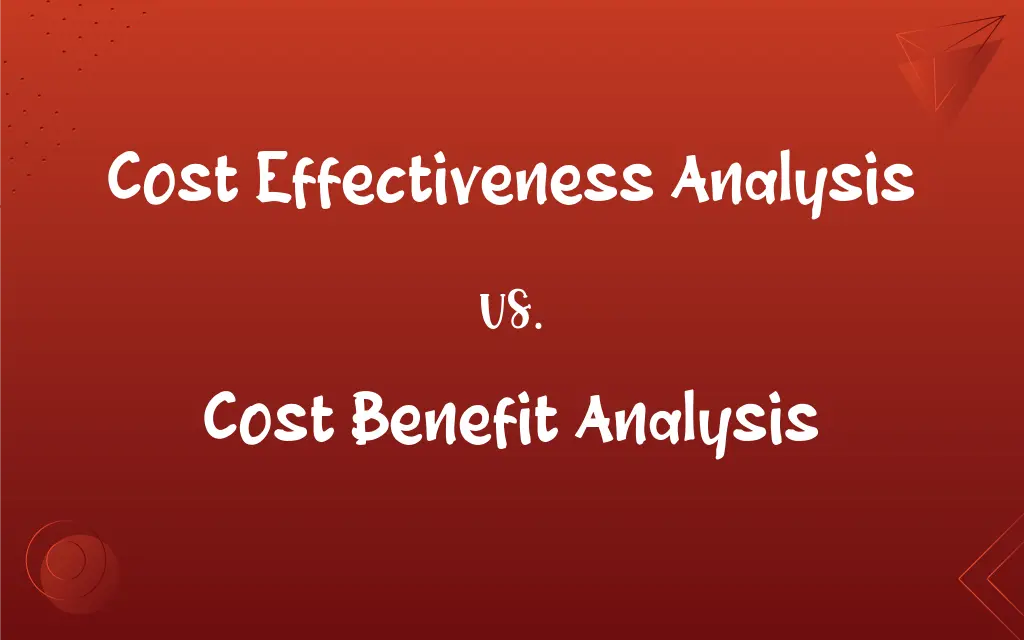Cost Effectiveness Analysis vs. Cost Benefit Analysis: What's the Difference?
Edited by Aimie Carlson || By Janet White || Published on March 5, 2024
Cost effectiveness analysis compares the relative costs of achieving the same outcome, while cost benefit analysis weighs the total costs against the total benefits in monetary terms.

Key Differences
Cost effectiveness analysis (CEA) is primarily used to compare the costs of different ways of achieving the same outcome. It is often used in fields like healthcare or education, where the goal is to determine the most efficient way to achieve a specific, non-monetary outcome. Cost benefit analysis (CBA), on the other hand, involves comparing the total costs of an action to its total benefits, both quantified in monetary terms. It is broader in scope, assessing whether the overall benefits of an action outweigh its costs.
CEA measures effectiveness in physical units, like lives saved or years of education gained, and does not convert these outcomes into monetary terms. It is concerned with finding the most cost-effective method among alternatives. CBA measures both costs and benefits in monetary terms, facilitating a direct financial comparison. It helps in determining whether a project or decision will result in a net economic benefit.
In decision-making, CEA is used when the outcome is fixed or predetermined and the decision revolves around how to achieve this outcome most economically. In contrast, CBA is used when decision-makers need to evaluate whether or not to undertake a project or how to allocate resources among various competing projects based on their net economic benefits.
CEA is suitable for projects where the primary objective is maximization of a specific outcome, not necessarily tied to financial gains. This is common in public policy and health interventions. CBA is more suitable for projects where financial returns or economic impact are key considerations, such as in infrastructure projects, policy decisions, or business investments.
CEA involves comparing the cost-effectiveness ratios of different alternatives to find the option that provides the best value for money in achieving the desired outcome. CBA involves a comprehensive assessment of all the costs and benefits associated with a project or decision, including indirect and long-term effects, to arrive at a net present value or benefit-cost ratio.
ADVERTISEMENT
Comparison Chart
Objective
Compare costs to achieve the same outcome
Weigh total costs against total benefits
Measure of Outcome
Effectiveness in physical units
Monetary value of costs and benefits
Decision-making Context
Outcome is fixed, method is variable
Whether or not to undertake a project
Suitability
Non-monetary outcome projects
Financial return or economic impact projects
Methodology
Cost-effectiveness ratios
Net present value, benefit-cost ratio
ADVERTISEMENT
Cost Effectiveness Analysis and Cost Benefit Analysis Definitions
Cost Effectiveness Analysis
Evaluates which option provides the best outcome per unit cost.
The CEA indicated which vaccine was most cost-effective for the immunization campaign.
Cost Benefit Analysis
Involves quantifying all costs and benefits in financial values.
The government's CBA showed the economic benefit of the environmental regulation.
Cost Effectiveness Analysis
Focuses on the efficiency of achieving a non-monetary goal.
A CEA was conducted to find the best value method for reducing road accidents.
Cost Benefit Analysis
Compares the monetary value of benefits and costs of a project.
A CBA was conducted to decide if building a new highway was financially justified.
Cost Effectiveness Analysis
Analyzes various alternatives to achieve a predetermined result.
CEA was used to compare different public health interventions for effectiveness.
Cost Benefit Analysis
Calculates the financial return of an investment or decision.
The CBA indicated a high return on investment for the technology upgrade.
Cost Effectiveness Analysis
Compares costs of different methods to achieve a specific outcome.
The hospital used CEA to determine the most economical treatment for a disease.
Cost Benefit Analysis
Determines the net economic value of different project options.
A CBA helped in deciding between alternative energy sources for the new plant.
Cost Effectiveness Analysis
Assesses cost relative to physical units of outcome.
CEA helped in choosing the most cost-effective educational program.
Cost Benefit Analysis
Assesses whether total benefits outweigh total costs in monetary terms.
The company used CBA to evaluate the profitability of launching a new product.
FAQs
When is CEA most commonly used?
In healthcare, education, and public policy for non-monetary goals.
Can CEA be used in business?
Yes, particularly for efficiency and operational decisions.
What is cost effectiveness analysis?
It compares the costs of different ways to achieve the same outcome.
What types of decisions use CBA?
Economic, business, and policy decisions with financial implications.
Is CBA suitable for non-profit projects?
Yes, if the benefits and costs can be quantified in monetary terms.
How does CBA handle indirect costs?
It includes them if they can be expressed in monetary terms.
Does CBA require a discount rate?
Often, to calculate the present value of future benefits.
What does cost benefit analysis do?
It compares the monetary value of all benefits and costs of a project.
Does CBA consider intangible benefits?
Yes, if they can be monetarily quantified.
What's a limitation of CEA?
It doesn't convert outcomes into monetary values.
Can CBA assess environmental projects?
Yes, by quantifying environmental benefits and costs.
How do timeframes impact CBA?
Longer timeframes require careful discounting of future values.
How does CEA measure outcomes?
In physical units like lives saved, years of education, etc.
What's a key difference in their methodologies?
CEA focuses on cost per unit of outcome, CBA on financial return.
Are CEA and CBA mutually exclusive?
No, they can be used complementarily in decision-making.
Is CEA used for budget allocation?
Yes, particularly in resource-limited scenarios.
Can CEA determine a project's profitability?
No, it assesses cost-effectiveness, not profit.
Is CEA or CBA better for health policies?
CEA is often preferred for specific health outcomes.
Can CEA be subjective?
It can be, in defining and measuring outcomes.
Is CBA applicable to small-scale projects?
Yes, if the costs and benefits are quantifiable.
About Author
Written by
Janet WhiteJanet White has been an esteemed writer and blogger for Difference Wiki. Holding a Master's degree in Science and Medical Journalism from the prestigious Boston University, she has consistently demonstrated her expertise and passion for her field. When she's not immersed in her work, Janet relishes her time exercising, delving into a good book, and cherishing moments with friends and family.
Edited by
Aimie CarlsonAimie Carlson, holding a master's degree in English literature, is a fervent English language enthusiast. She lends her writing talents to Difference Wiki, a prominent website that specializes in comparisons, offering readers insightful analyses that both captivate and inform.































































